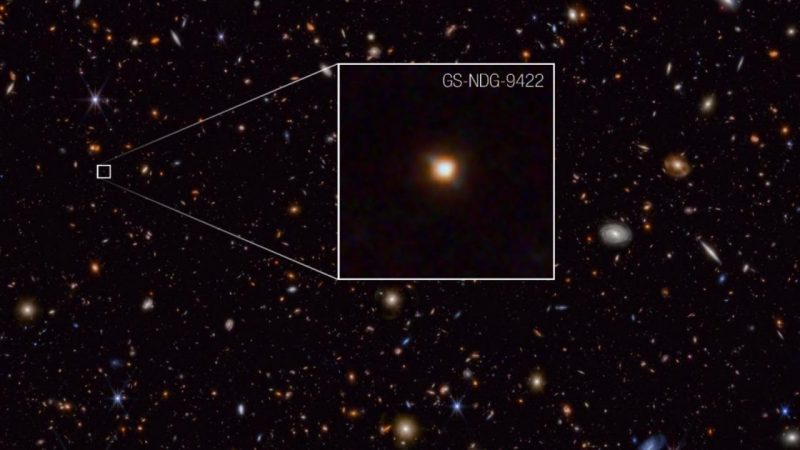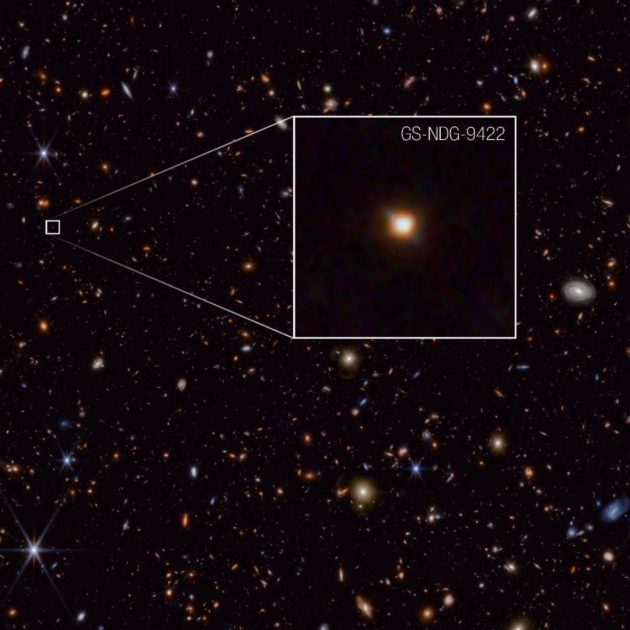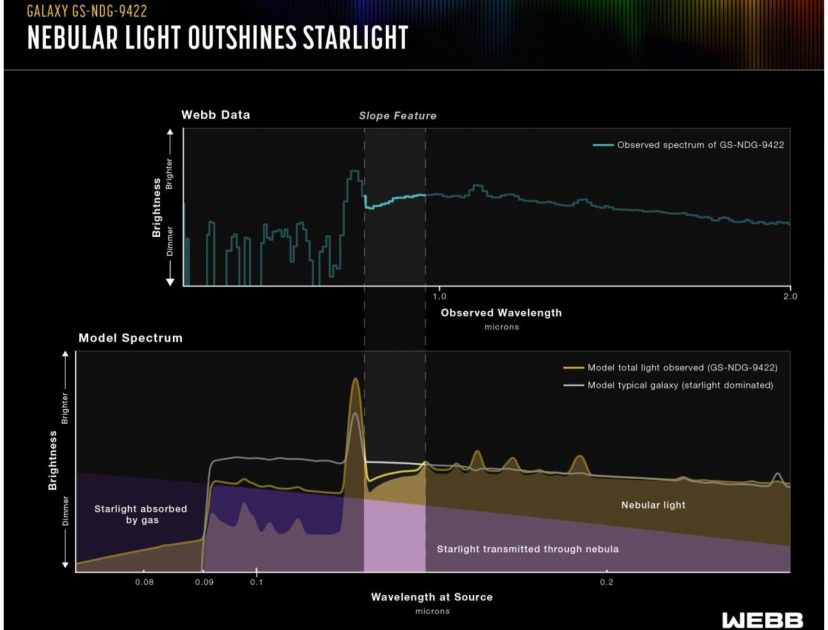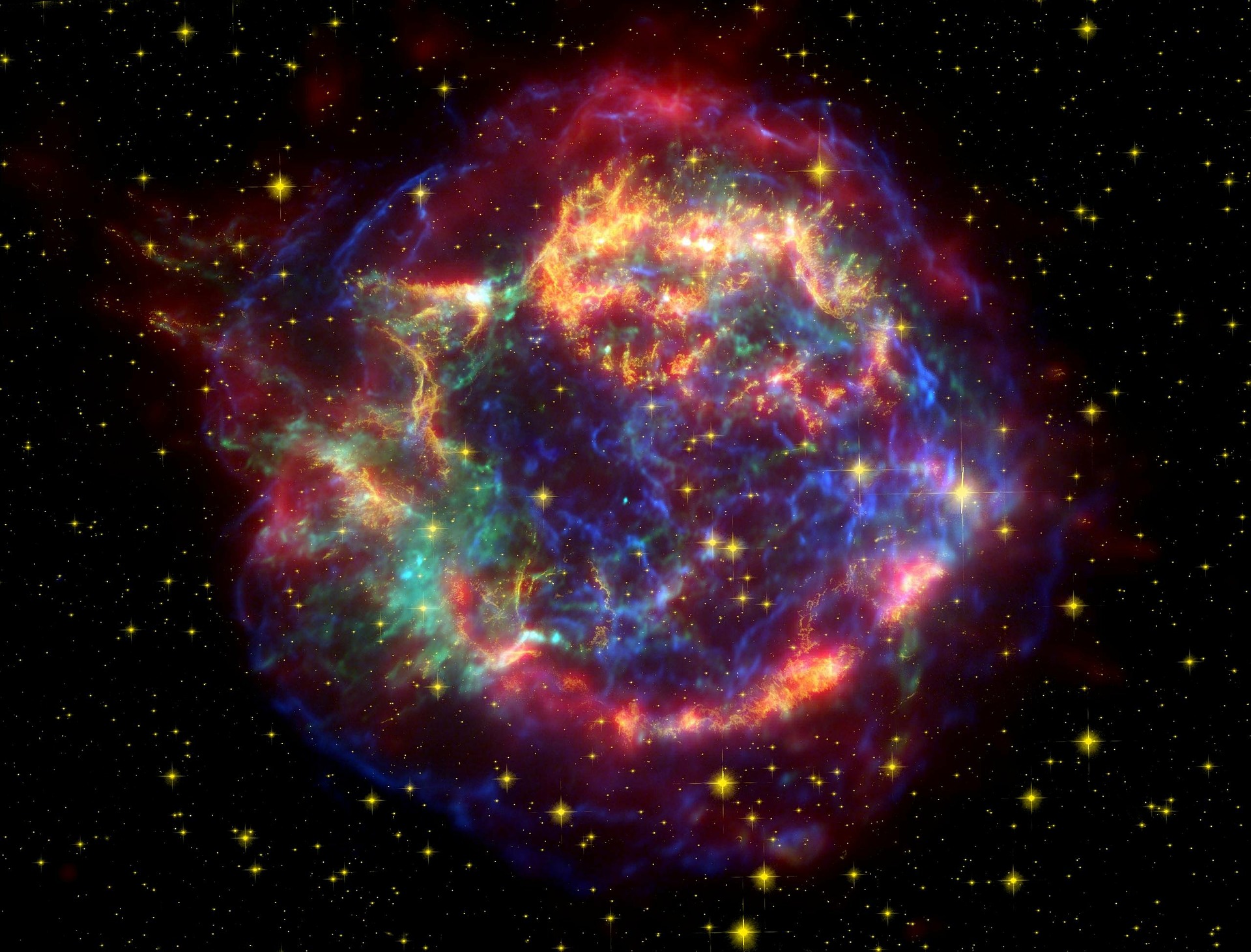James Webb Telescope identifies hot gas in early, baby galaxies: What it means for stellar and galactic evolution

Since its launch into orbit in December 2021, NASA’s James Webb Space Telescope has amazed scientists, astronomers and researchers with remarkable discoveries, exploring the farthest and darkest regions of the universe by using its advanced infrared technology to reveal stunning details of celestial events. One of its most significant findings is the discovery of galaxy GS-NDG-9422, which has revealed an extraordinary phenomenon: gas in early galaxies shining brighter than their stars due to extreme temperatures. Researchers found that the stars within this galaxy are so intensely hot, reaching over 140,000 degrees Fahrenheit (80,000 degrees Celsius), that they heat the surrounding nebular gas, causing it to emit more light than the stars themselves. This finding has challenged current models of early galactic evolution and provided new clues about the formation of stars and galaxies during the universe’s infancy.

Unlike what existing theories posit, this galaxy indicates a uniquely complex interaction between stellar and gaseous components during the early phases of galactic development. GS-NDG-9422, situated roughly one billion years after the Big Bang, could represent a missing link between the universe’s first stars and the more familiar galaxies we observe today.
The Webb telescope was specifically designed to unveil such unprecedented phenomena. “My first thought in looking at the galaxy’s spectrum was, ‘that’s weird,’ which is exactly what the Webb telescope was designed to reveal: totally new phenomena in the early universe that will help us understand how the cosmic story began,” said lead researcher Alex Cameron from the University of Oxford. This capability to detect odd light signatures and other peculiarities in the early universe is essential for understanding how cosmic structures evolved.
Research suggests that the massive stars within GS-NDG-9422 are substantially hotter than typical stars seen in the local universe. While hot, massive stars generally have temperatures ranging from 70,000 to 90,000 degrees Fahrenheit (40,000 to 50,000 degrees Celsius), the stars in this galaxy astonishingly exceed 140,000 degrees Fahrenheit. This heightened temperature produces an immense number of photons. These photons, in turn, ionize the surrounding gas, which becomes a luminous entity in its own right, thus challenging previously held assumptions about the relationships between star formation and gas dynamics.
The research findings from the study of galaxy GS-NDG-9422 raise critical questions about star formation in the early universe. Observations reveal that the galaxy exhibits low metallicity, with levels less than 0.1 times the solar abundance. This indicates a scarcity of heavier elements synthesized by previous stellar generations. As a result, stars forming in this environment are likely to have a different mass distribution than those formed in later generations. Researchers notably suggest that this could imply a “top-heavy” stellar initial mass function (IMF), in which massive stars are more prevalent than smaller ones. This contrasts sharply with the more balanced IMF observed in mature galaxies.
“It looks like these stars must be much hotter and more massive than what we see in the local universe, which makes sense because the early universe was a very different environment,” said Katz, of Oxford and the University of Chicago.
The galaxy’s spectral features reveal a sharp turnover in the ultraviolet (UV) continuum, often indicative of nebular emissions. This observation supports the hypothesis that GS-NDG-9422 may be undergoing a brief phase of intense star formation. Researchers propose two primary scenarios to explain its emissions. In the first, the ionizing source of the galaxy’s emissions has recently ceased, leaving a lingering signature of ionized gas. In the second, the emissions are dominated by extremely hot stars, similar to Wolf-Rayet stars, which produce large amounts of ionizing radiation.
Using diagnostic diagrams that compare observed line ratios with theoretical models, researchers have demonstrated that GS-NDG-9422 aligns more closely with star-forming models than with those associated with active galactic nuclei (AGN). This suggests that the ionizing emissions are likely of stellar origin rather than from an accreting supermassive black hole. These findings are crucial for deepening our understanding of star formation in early galaxies and the role of gas dynamics in this process.

Furthermore, the nebular emissions detected in GS-NDG-9422 uncovers the conditions that prevailed in the early universe. Observations suggest that early galaxies were immersed in intense radiation from massive stars. The relationship between gas and stellar components is highlighted by the detection of strong Balmer emission lines, which indicate high ionizing photon production efficiencies. This emphasizes the role of hot stars in shaping the ionization state of surrounding gas and underscores the importance of understanding how these stars influence their environments during periods of rapid star formation.
As scientists analyze these findings, they are confronted with broader questions about the evolution of stellar populations in high-redshift galaxies. Observations from GS-NDG-9422 suggest that conditions favorable for the formation of massive stars may have been more prevalent than previously thought. This could significantly impact our understanding of the cosmic star formation rate during the universe’s infancy. A more refined understanding of star formation rates in these environments may help improve models of cosmic evolution, particularly those related to galaxy formation and the eventual emergence of the diverse array of galaxies observed today.
“We know that this galaxy does not have Population III stars, because the Webb data shows too much chemical complexity. However, its stars are different than what we are familiar with – the exotic stars in this galaxy could be a guide for understanding how galaxies transitioned from primordial stars to the types of galaxies we already know,” said Katz.
In addition, the discovery of nebular gas outshining stars is a striking reminder that our understanding of the cosmos continues to evolve. Astronomers are now re-evaluating existing models of galactic evolution to incorporate findings such as those from GS-NDG-9422. Researchers are keen to ascertain whether this phenomenon is unique or if it reflects a broader trend among early galaxies. Identifying additional galaxies exhibiting similar characteristics could pave the way for a more comprehensive understanding of early galactic formation processes.
One particularly interesting aspect of the ongoing research is the potential for GS-NDG-9422 to serve as a prototype for future studies. If additional examples of galaxies with similar properties can be found, they may provide new avenues for exploring the early universe and answering critical questions about cosmic history. The Webb telescope has positioned itself as an essential tool for this exploration, allowing astronomers to probe deeper into the early cosmos than ever before.
In the broader context of cosmic evolution, these findings underscore the interconnectedness of stars, gas, and galaxies. The relationship between stellar formation and nebular gas dynamics is intricate, and the insights gained from studying GS-NDG-9422 highlight the complexity inherent in early galaxy formation processes. The nebular-dominated emissions observed in this galaxy are a testament to the dynamic interplay between hot stars and the surrounding gas, offering a glimpse into the formative stages of cosmic structures.
Researchers have been eagerly searching for remarkable insights in every new data set from the James Webb Space Telescope, and their enthusiasm for further discoveries has grown stronger in parallel. The early universe remains shrouded in mystery, and each new finding enhances our understanding of vast issues, including the processes of galaxy evolution.
“It’s a very exciting time, to be able to use the Webb telescope to explore this time in the universe that was once inaccessible,” Cameron said. “We are just at the beginning of new discoveries and understanding.”
Yes, Cameron rightly noted that ‘it’s a very exciting time’ as we use the Webb telescope to explore parts of the universe that were previously out of reach. The discovery of hot gas in early galaxies like GS-NDG-9422 is important for our understanding of how stars and galaxies evolve and prompts a reevaluation of established models of the universe and our origins.
The research paper is published on June 21, in Monthly Notices of the Royal Astronomical Society, Volume 534, Issue 1.


